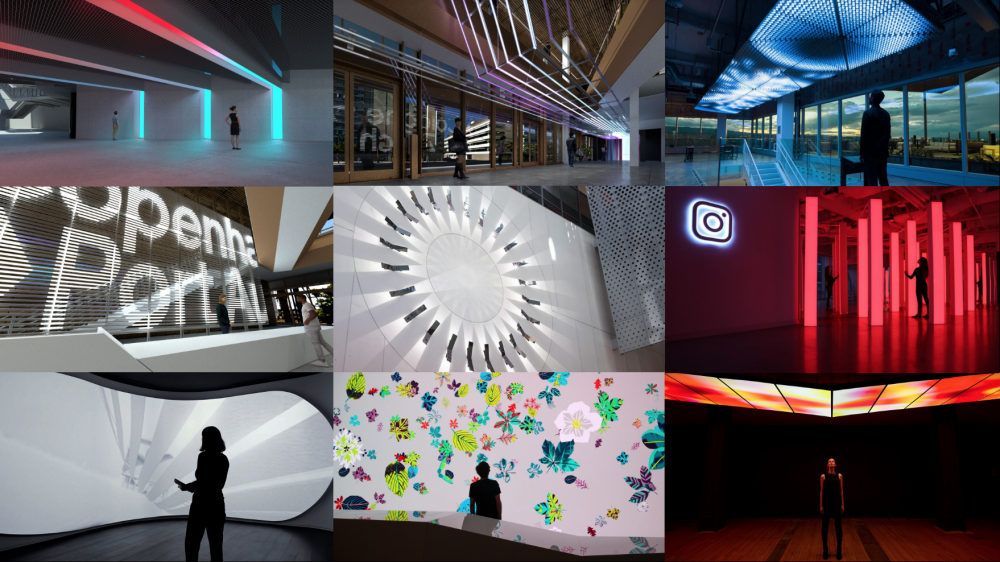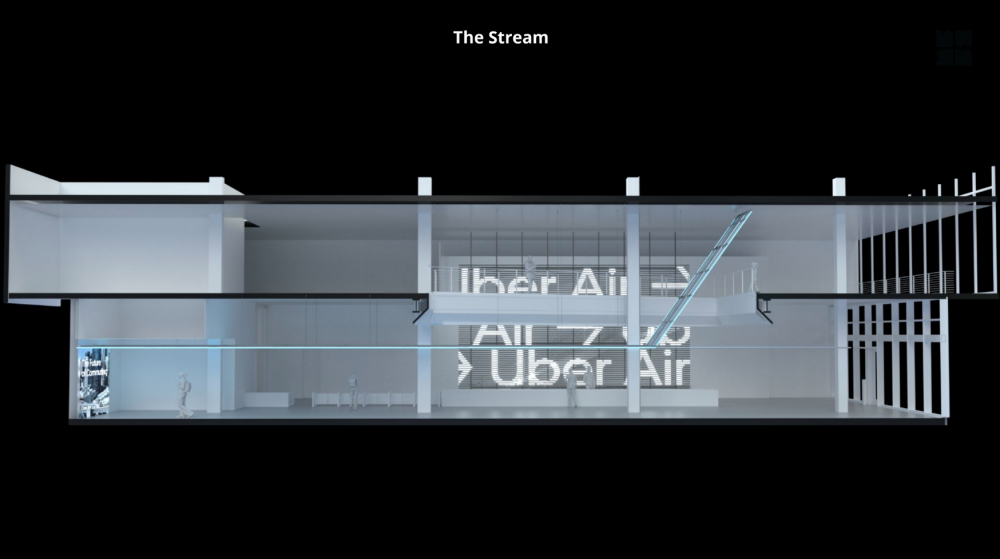This designer from NeoCon’s recent virtual program believes the death of the office has been greatly exaggerated and that workplace design will take an evolutionary leap.
As we assess the effects of the pandemic, some have predicted the death of the workplace entirely. David Schwarz of HUSH, however, thinks this death has been greatly exaggerated and that the design of the workplace will take an evolutionary leap, not a mere shift in program. A new model of program and value – one based primarily on qualitative brand experiences that leverage the inspirational scale of architecture, and foster employee collaboration through interaction and technology – will be the light that draws us back. The seeds of this are evidenced in his firm’s work with Uber in creating an interactive lobby experience called ‘The Stream’ for their new campus in Mission Bay, San Francisco.
As part of theMart’s NeoCon 2021 Design Anew programming, David’s presentation pointed out that as we re-think the workplace, adding dynamic elements to create unique experiences is one way we can be more creative about presenting the workplace with a new perspective. Designing and building spaces that foster an awareness of a company’s culture and branding is one way to make spaces not only more exciting but informative. How do they do that? We caught up with David post-event to address some follow up questions about the work presented in his informative, visually rich, and most interesting presentation.

A key point, early on in the presentation graphically shows how inspiration can build from the right kind of experience.
Explaining that digital experiences in the workplace can maximize inspiration, and help organizations recruit and retain talent, and motivate action around a shared purpose, David highlighted projects that employed these experiences to enhance their facilities.

Employees seek both efficiency and inspiration. With hybrid work, the scale of the workplace becomes truly differentiated in its ability to provide the inspiration that is impossible to feel at home. To maximize inspiration, digital experiences should be designed to gather people around a shared purpose and provide a sensorial connection to their community. Better together.
Architecture is static-ish. Digital is interactive. Digital experiences inspire more deeply as people connect, seek out, discovery and interact. With these points in mind, we put forward the attendee and WDM questions to get further background work HUSH does to elevate the “office” to a more dynamic workplace.

In the current scenario, all of us are dependent on digital media, social apps and software. What makes you believe that digitalization of a space is what’s going to induce real-time, face to face interaction? Will this ideation of scale, people, and interaction keep the urban realm alive?
David Schwarz: I don’t think digital media is a requirement to keep the urban realm alive, it’s just a huge and interesting design ingredient that can connect our virtual and IRL lives. I believe that human beings are social animals, desiring companionship, communication, and interaction, as well as being inquisitive, curious and explorers, by nature. Whether seeking ideas or inspiration, the urban environment is that intersection.
However, at HUSH we believe that we should live a more “heads up” digital life – meaning, the digital should meet the scale of the urban environment. We spend plenty of time looking down at our digital rectangles which represent personalized, private, and curated information sources and incredibly refined, pixel perfect UX interactions that are optimized for speed and efficiency.

That kind of UX doesn’t translate to the urban scale. When designers attempt to transpose “heads down” paradigms of content and information consumption to the scale of urban architecture, commercial and retail spaces, workplaces, etc. you end up with folly – those digital expressions that go unnoticed, unseen, or worse, blinding representations of an experience not meeting the desires of their audiences.
Architectural scale environments warrant a slew of unique “heads up” digital experiences that softly and deftly add information and ideas, inspiration, and curiosity to the world around us as we venture through it, in motion, through perspective and scale change, over time.
Do you think technology-heavy spaces are resilient and timeless, especially as we think long-term? It seems somewhat contrary to the back-to-basics principles mentioned in the presentation.
David Schwarz: Technology has a reputation for not aging well – but that’s because most firms attempt to design with technology that is intended to telegraph a kind of futurism, a kind of latest-greatest sci-fi expression. The Future is here before we know it, so these kinds of designs tend to feel passé the moment they’re deployed, and the ribbon cut.
Moreover, I think the focus on technology is a distraction. Here’s why: you could say the same about architecture or branding. Buildings designed to feel “futuristic” can feel anachronistic in a decade, or even sooner. Brand identities pushing the latest aesthetic trends, typography and on-trend color palette are forever attached to that moment in time, like fashion. They were hot. Now they’re not.

So, this problem of designing for enduring value and a sense of timelessness has been ever present across design fields. There have been successful designs (experiential, technological, brand, architectural) that seem to possess an uncanny longevity. At HUSH we strive for a similar kind of quality, where the way technology is integrated seamlessly into space and materials mean that audiences aren’t attracted to a specific tech-thing, but rather to the overall feeling – the gestalt – of the experience.
This is a guiding principle.
Is designing an experience for the workplace different than designing for other types of spaces? If so, how?
David Schwarz: The work we do for the “workplace” is actually quite specific. Compared to large architectural firms who are helping organizations think about the sum total use of their space, program and needs, we actually are focused on designing the areas in the program that deliver two critical things: emotional inspiration and incentivize collaboration – in that order.
We think about an organization’s workplace as the ultimate representation of its culture. It’s the substantive, three-dimensional message to its employees and most valued partners. As such, we focus on designing experiences that deliver that message in an enormously inspirational way the first time someone arrives, and in evolved ways every day thereafter.


As such, the workplace drives inspiration, helping organizations attract and retain the best talent in the marketplace, and aligning them daily on the organization’s “why” at the highest levels.
Collaboration is the result of inspiration, not the catalyst for it. Without inspiration, there simply is no collaboration among employees. Think of a company as a sports team. Do teams play together at the Olympic level without being incredibly motivated by a singular, inspirational vision? No.
If we can design ways for the workplace to feel incredibly inspirational, employees will use that energy to motivate collaboration in amazing ways. Therefore, we’re also designing experiences that provide a spatial framework, the interactive tools and information to incentivize group collaboration. We’ve created experiential spaces that engage employees and partners in dialogues that open up opportunity and exploration through collaborative, interactive, multi-dimensional behaviors. We leverage all five senses to help people communicate, share and progress together.
Do you think there is a future possibility to design experiences that are powered by alternative resources? Is there would be a way to use solar, wind, or waterpower, for example, to fuel the installations?
David Schwarz: Absolutely. There’s an interesting tension between digital experiences and sustainability. Often, digital technology can be seen as being antithetical to sustainability goals – anything from it adding unwanted energy load to a building, to technology hardware having little afterlife.
As with any tension, there is also a beautiful balance possible if sustainability is moved to the foreground in the design equation. This was the case in one of our most celebrated projects for the biotech company United Therapeutics. Their new campus building was 100% site net zero, and we created all of the experience design within the workplace to tell this important sustainability story. But in using technology, we had to account for every additional packet of energy spent, as well as the material impacts over the long term, to stay within the energy budget of the building.

As such, our digital experiences are actually powered by the building’s solar system and activated by the real-time data of the energy flowing invisibly through the building’s engineering systems.

We achieved this balance of design in a really compelling way that we’re applying to other projects with a similar thesis. Energy is an important but invisible story that if visualized effectively and responsibly through digital experience design, supports an organization’s culture and vision.
Connect with HUSH:
LinkedIn | Instagram | Facebook
This article is supported by the following 2021 NeoCon Exhibitors:





